Top 5 cannabis extraction methods

Many cannabis lovers enjoy the more intense, profound and trippy effects of cannabis extracts. Although cannabis concentrates can be expensive to buy, they can be made cheaply by the home grower from their spare plant material. Excellent quality cannabis concentrates can be made from waste plant trimmings, leaves and popcorn buds. We explain all you need to know about the Top 5 cannabis extraction methods, how they work and what you can expect from the finished cannabis extracts.
What are cannabis extracts
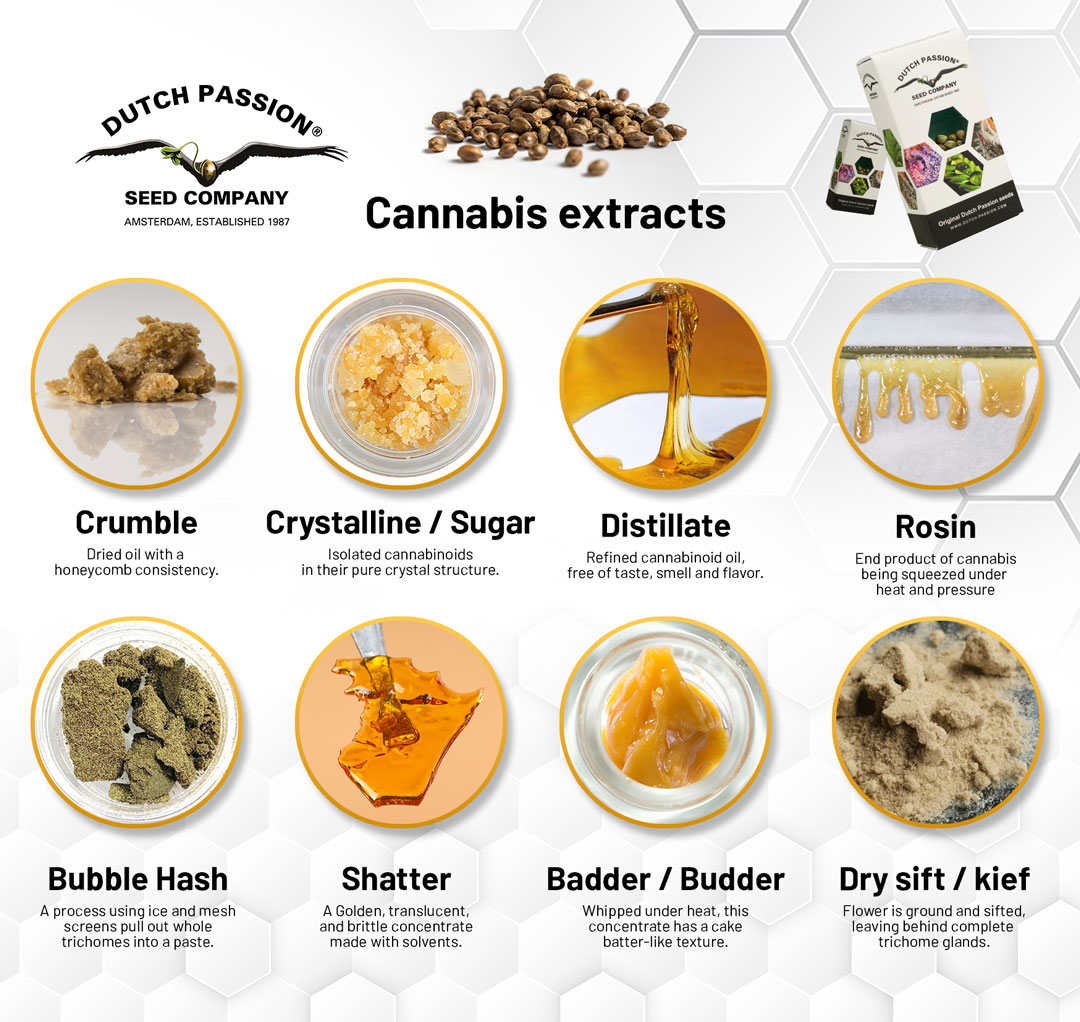
Cannabis extracts (or cannabis concentrates) are made by removing the psychoactive cannabinoids, oils and cannabis terpenes from the host plant material. Once extracted, and the plant cellulose/fibre material is removed, the remaining cannabis concentrate should be substantially more potent than the original buds/sugar leaves etc.
Cannabis extracts allow a premium potency product, even if the original plant material used to create it (e.g. fan leaves, trimmings, sugar leaves etc) was low potency. Although many cannabis growers do recycle their harvest trimmings to make cannabis extracts, some growers regard the process of making extracts to be too complicated.
However, as discussed below, even a small amount of effort can result in seriously high-quality cannabis concentrates for the grower.
Solvent-based vs organic extraction methods
All the various cannabis extracts are created using the same principle. Namely, to strip the cannabinoids (THC, CBD etc), terpenes and oils away from the plant fibre and concentrate them into a more potent form.
This can be done via solvent extraction methods using IPA, Butane, Ethanol etc. Some cannabis extracts can be made without solvents - so called ‘solvent-free’ or organic extraction methods. When done well, both methods can produce connoisseur quality cannabis concentrates that slap hard.
Some extraction methods can be performed quickly and relatively easily by the home grower. But some are best suited to professional commercial cannabis producers who can afford the (sometimes) expensive equipment & safety gear required.
Solvent-based extraction methods
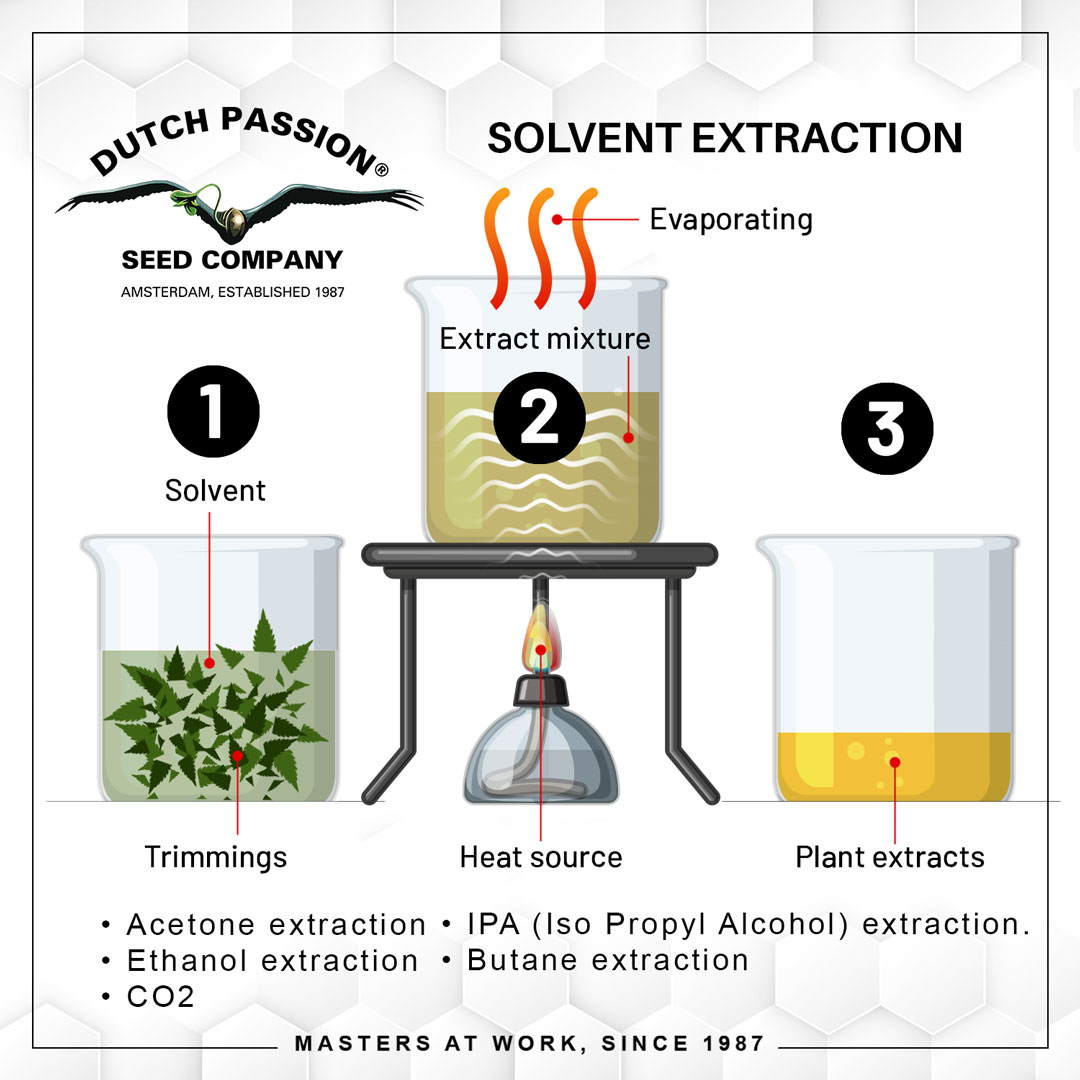
Solvent based cannabis extraction methods rely on the fact that cannabinoids, natural plant oils and terpenes will readily dissolve in certain solvents. After soaking in the solvent, the cannabis buds/leaves/trimmings are removed by filtration.
The solvent is removed by evaporation. Once the solvent has evaporated the pure cannabis extract is ready to be enjoyed. THC levels may be around 50%-80%, two or three times the potency of top-quality buds.
The host plant material is then often discarded - with no cannabinoids, oils or terpenes all that remains is waste cellulose.
Related methods list:
- Acetone extraction
- Ethanol extraction
- IPA (Iso Propyl Alcohol) extraction.
- Butane extraction (producing Butane Honey Oil or ‘BHO’). Butane extraction is also used extensively in the food/perfume industry.
- CO2 - Carbon Dioxide extraction, sometimes called supercritical (low temperature) CO2 extraction. Favoured by professionals, but with expensive initial set-up costs.
Pros:
- Seriously powerful and pure concentrates can be easily and inexpensively produced. Often from leaves, trimmings, popcorn buds etc which may have otherwise simply been disposed of.
Cons:
- To some purists, use of solvents when extracting cannabis is less preferred. Any residual non-volatile impurities in the solvent may remain after evaporation.
- Others worry about the environmental impact relating to solvent use & manufacture.
- Risk of fires/explosions can pose a serious risk to anyone using solvents. Especially indoors, where explosive vapours can accumulate quickly. Use of flammable solvents to produce cannabis extracts is undeniably a risk, and one that can be avoided.
- The extracts must be carefully dried (vacuum ovens are ideal for this) to ensure that no solvent remains.
- Some up-front investments may be needed for equipment (BHO extraction tubes, vacuum ovens etc).
Solvent-free extraction methods
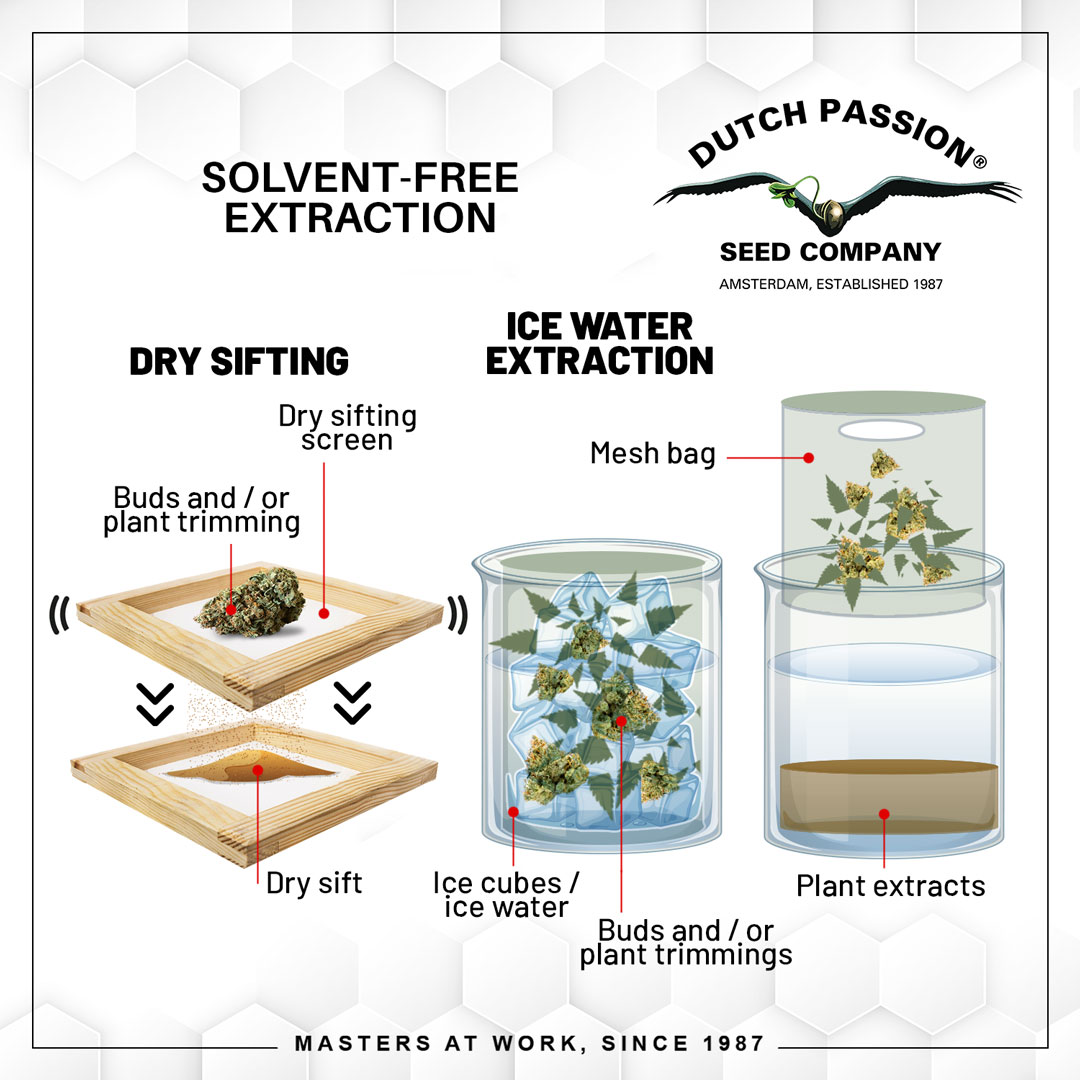
If use of solvents feels like too much complication/risk, then you can consider some proven solvent-free extraction methods. These have the obvious safety & environmental benefits. Your extracts are also free from any residual solvents, and free from any non-volatile impurities that were within the solvents.
Related methods list:
- Dry sifting. Buds/plant material are shaken on a screen, allowing trichomes to pass through and be collected.
- Ice water extraction. Plant material is mixed in ice/water, the trichomes are mechanically separated from the host plant tissue and collected in hash bags.
- Rosin extraction. Plant material is squashed in a metal vice, sometimes under heat. Cannabis oil oozes out of the plant material and is collected. This ‘rosin’ oil is rich in terpenes and cannabinoids. Rosin presses are increasingly popular and affordable.
Pros:
- With no solvents involved in the production of cannabis concentrates there is no risk of residual solvents/contaminants in the finished cannabis extracts.
- You can reach the same potency/quality levels as cannabis extracts made with solvents.
- Without the dangers of flammable/explosive solvents, these are the safest methods to produce cannabis extracts. Especially for the typical home grower.
Cons:
- Some commercial cannabis extraction specialists feel that solvent based methods, despite their concerns, allow faster & higher volume production of cannabis concentrates at the greatest efficiencies.
What are the most efficient cannabis extraction methods?
Your preferred method of cannabis extract production will depend largely on your attitude towards the safety aspects regarding solvent vs solvent-free methods. It may also depend on the available budget.
Here are 5 of the most common cannabis extract production methods for home growers. However, it should be strongly stressed that solvent-free methods are by far the safest (and therefore the only recommended) routes for domestic home growers.
Solvent based cannabis extraction methods are recommended only to those with the right equipment & training - generally professional extractors.
1. BHO, Butane Honey Oil cannabis extracts
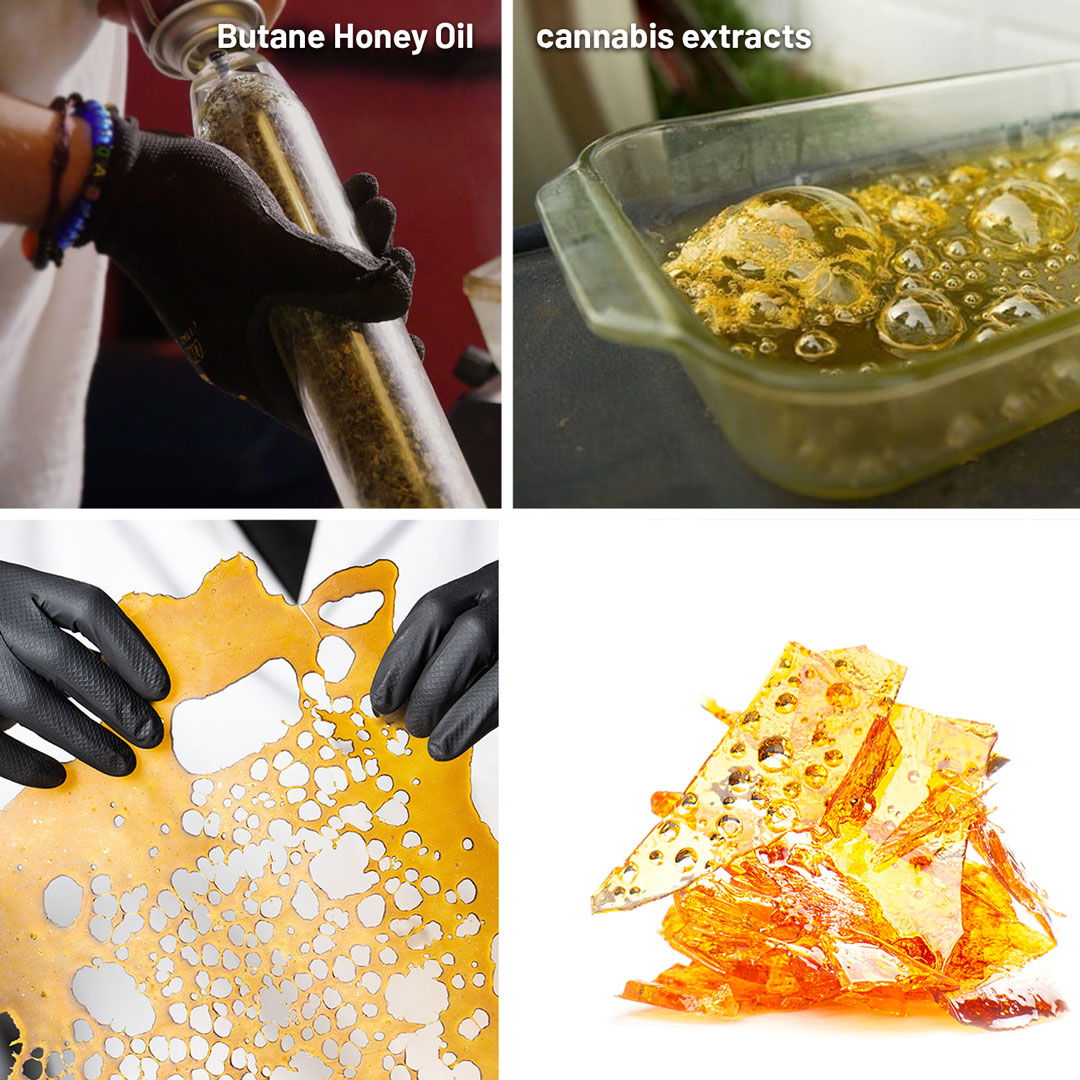
Although it is one of the most dangerous cannabis extraction methods, making BHO cannabis extracts remain surprisingly popular with home growers.
Note that the entire BHO process produces clouds of flammable/explosive vapour and is extremely dangerous.
Pros:
- A fast process that allows for large quantities of high-quality cannabis extracts.
- Relatively inexpensive in terms of equipment (metal tube) and consumables (Butane canisters)
Cons:
- Massively dangerous if done incorrectly, despite the benefits. Many amateur extractors have caused fires/explosions because of the flammable gasses involved. Especially when conducted indoors without professional extraction equipment and vapour removal.
Best for:
Licensed professionals that can safely manage the risks and want a scalable, simple, method to make high-THC BHO cannabis extracts.
Equipment needed:
Depending on your volume ambitions, you will need an appropriately sized extraction tube as well as a supply of pure (contaminant free) Butane. You may also need to invest in a vacuum oven (or similar) to safely and completely remove the residual traces of butane. Vacuum ovens cost a few hundred €/$/£ dependent on the size.
Step-by-Step extraction process:
The principle generally involves a metallic (often stainless steel) cylinder with a gauze at the bottom end to keep the plant material (buds, leaves, etc) inside. The metallic cylinder is placed in a vertical position. At the top end, canisters of Butane (or propane) are discharged.
The butane enters the cylinder and flows down through the plant material dissolving the cannabinoids, terpenes and plant oils as it goes. This highly flammable/explosive liquid drips out of the bottom of the tube and is collected.
Once the Butane is evaporated (vacuum ovens are ideal for ensuring full removal) you are left with a potent BHO (Butane Honey Oil) cannabis extract. Despite being popular with home growers, BHO extraction remains the most dangerous option for producing cannabis extracts and can’t be recommended.
2. Cannabis ice water hash extraction
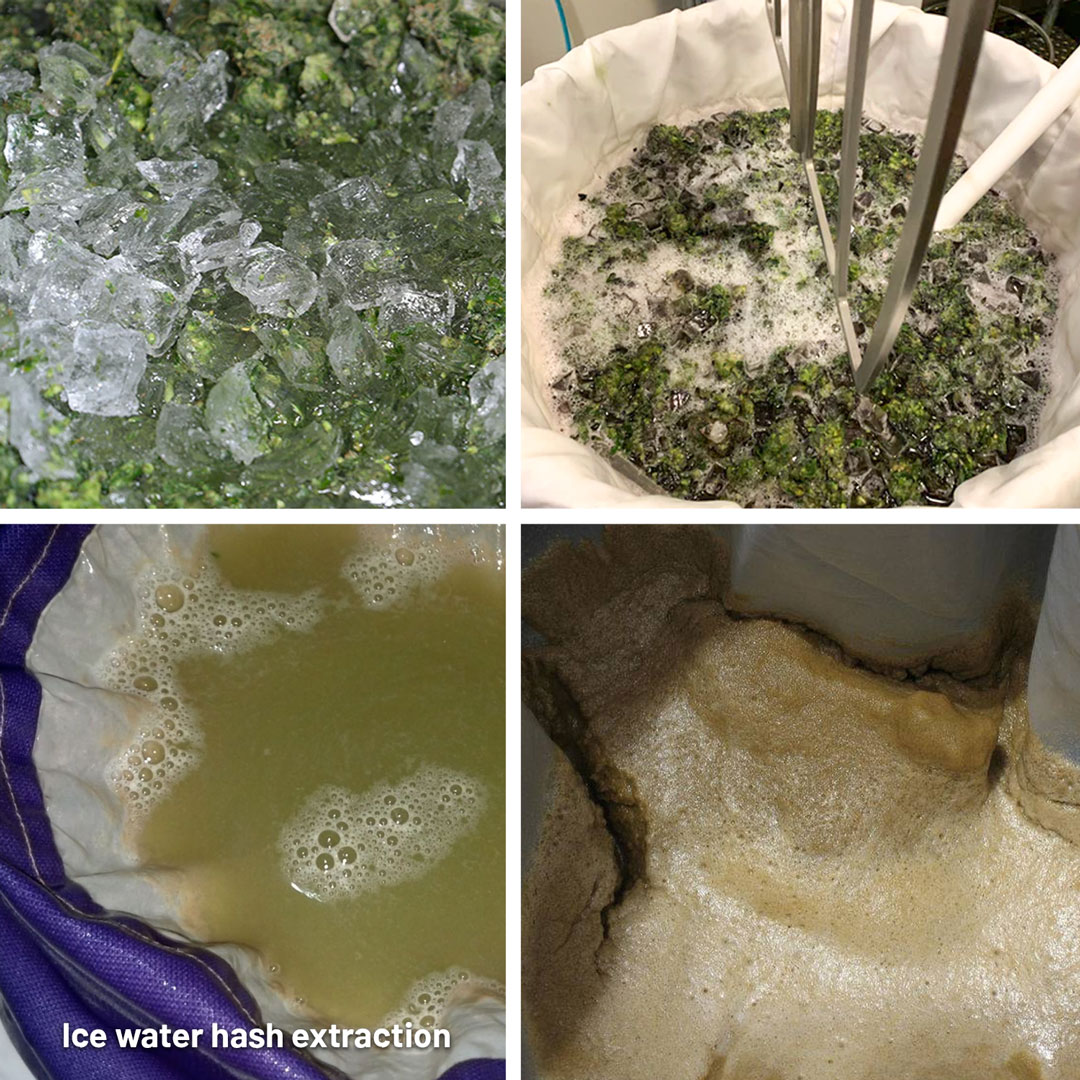
Top quality, extremely flavoursome ice water hash can be made simply without the use of any solvents. The principle is exactly the same as all other types of cannabis concentrates & cannabis extracts. Namely that the plant fibres and cellulose are removed leaving behind the concentrated cannabinoids, oils and terpenes. You will need an hour or two, some ‘hash bags’, water and a few bags of ice from the supermarket.
Pros:
- Solvent free! Low risk, very safe and reasonably fast.
- Savour the unique deep, rich hash scents and enjoy full-melt cannabis extracts.
Cons:
- You may need to gradually fine-tune your hash making technique to rival the same efficiencies/yields that you could get from other methods, e.g. BHO, rosin etc.
- You will need to invest in some hash bags. This cost around €50-100 for a set - usually around 3-6 bags in a set. Hash bags have a fine mesh with a different pore size to the next bag. Each bag collects trichomes of the appropriate size. This allows you to collect and produce a range of different hash types, from blonde to brown. A connoisseurs delight!
Best for:
Ice Hash, despite the effort and time required to make the finest samples, is a popular technique. Especially with home growers wary of solvent-based cannabis extraction methods.
Equipment needed:
A large container, frozen (or less preferred is fresh) trim, a few bags of supermarket ice cubes & a mechanical (electrical) powered stirring device. The colder the room equipment and conditions the better the results. This must be emphasised.
Step-by-Step extraction process:
Put some cold water into your mixing bucket and add the ice. Leave for 5 minutes until the water is ice cold. The larger the container, the more plant material you can use (alongside more water & ice). Add the cannabis plant material and allow to soak for around 30-40 minutes adding more ice if required.
Finally stir for around 5-10 minutes. During the stirring, any frozen trichomes that are still attached to the plant material are mechanically separated from it. Some ambitious home growers use large tubs (100 litres +) of ice/water and trimmings from several plants using ‘bucket mixers’ - these are available from any DIY supplier.
At the end of stirring, the water/ice/cannabis mixture is poured carefully through the hash bags. Read the instructions carefully and ensure you have the hash bags nested inside each other in the correct order.
A mushy, damp deposit of trichomes collects in each hash bag. You may notice air bubbles in this wet hashy mix, this is where the term bubble hash comes from. The ‘bubble hash’ is carefully scraped out and left to dry for a few days. Then, the dry & powdery hash can be rolled in the palm of your hand if you want to make a ‘charas ball’ of sweet, shiny hash.
Piatella is a new form of cold-cured hash, popularised in the Barcelona area it is now appearing in other countries such as The Netherlands & USA. Created only from the best buds, using the ice-hash technique, the aim is to collect the finest bubble hash (sometimes called 6-star bubble hash).
Instead of being air-dried and pressed with heat (eg from your hands), Piatella is cold cured - the aim is to prevent air-oxidation (and subsequent terpene loss). By cold curing, the trichome resin glands remain intact rather than immediately bursting. The bubble hash is collected and freeze-dried, this removes the water without addition of heat.
Once freeze-dried, the hash is placed in a vacuum bag and vacuum pressure applied for a long cold cure, forming the Piatella into a block at temperatures of 40-50F (never exceeding 60F). This causes the Piatella to congeal together into a solid mass. Sometimes the Piatella ‘sweats’ terpenes on its surface. Quality levels, taste and effect are sublime and highly sought after.
| Related: |
| How to make hash from ice and water |
3. Cannabis rosin extracts
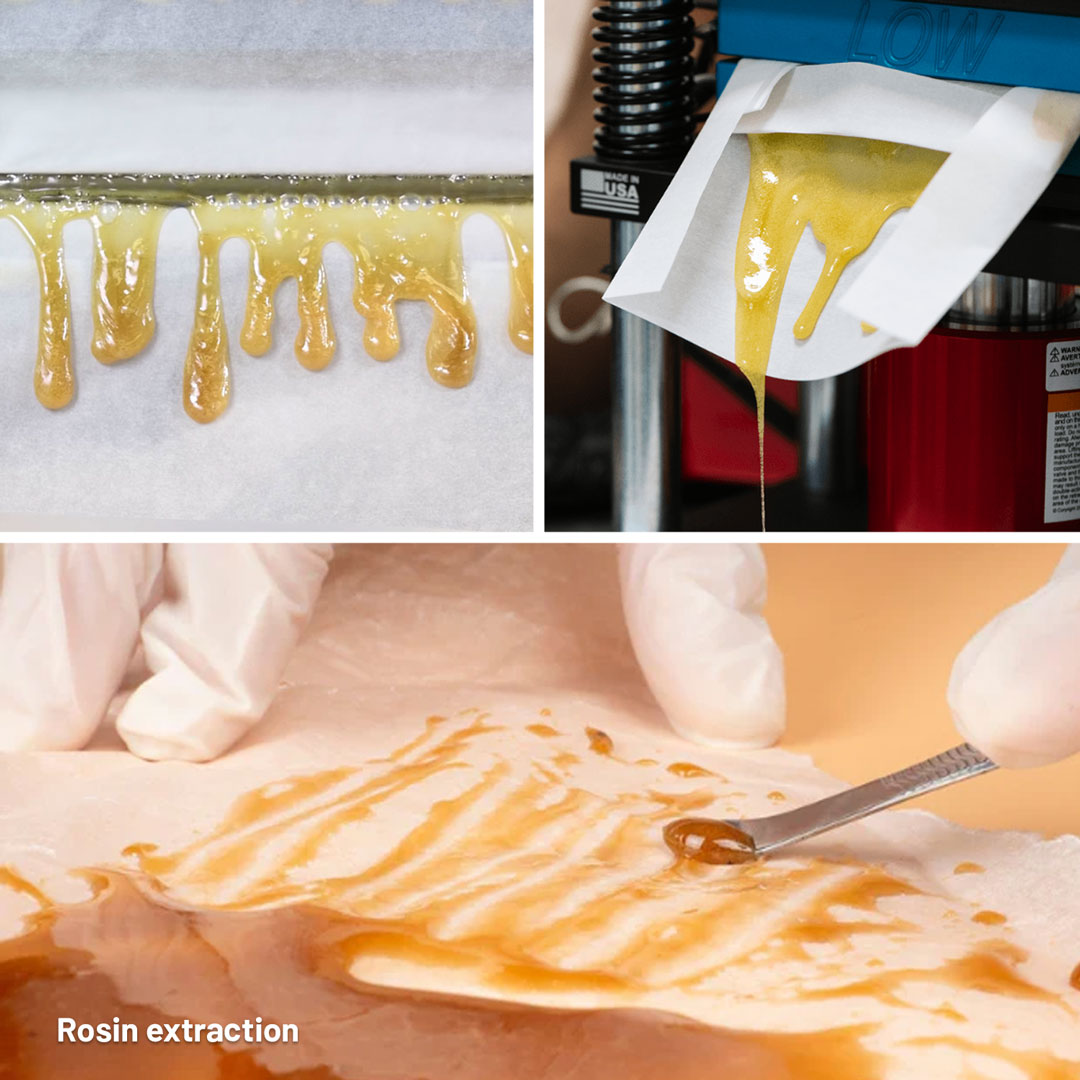
A far safer alternative to BHO extractions, cannabis rosin can be produced to very high quality/purity levels without the use of explosive gas.
Pros:
- Fast. Rosin can be made simply by squashing a bud under pressure but heat is almost always used. It’s highly recommended to use heat.
- Simple. In its simplest form, all you need is a pair of hair-straighteners and some grease-proof kitchen paper. Rosin aficionados buy a rosin press (widely available online) which allows them to quickly convert large amounts of weed/trim into high quality cannabis rosin.
- High quality. Expect excellent quality cannabis extracts which are ideal for dabbing, vaping etc.
- Safe. No organic solvents, no concerns about air ventilation or fire/explosion risks.
Cons:
- Unless you have a specialist mechanical press, production of large quantities of cannabis concentrates can be slow.
- A dedicated cannabis rosin press will cost a few hundred €/$/£. Costs have reduced significantly in recent years. A range of different size rosin presses are available, some also heat the plant material to help improve extraction efficiency.
Best for:
Domestic or professional cannabis concentrate users that prefer the solvent-free approach.
Equipment needed:
A pair of hair-straighteners and some grease proof paper will allow you to practice making your own rosin, one bud at a time. Simply place a bud inside a folded piece of greaseproof paper and squash inside some hot hair straighteners. Eventually you will notice the cannabis oil oozing out of the bud and depositing itself on the grease proof paper where it can be scraped up.
The more ambitious will invest in a cannabis rosin press, available in a range of sizes.
Step-by-Step extraction process:
The principle is that cannabis oil (complete with terpenes and cannabinoids) can be squeezed out of the host plant material when pressure is applied. One advantage of buying a specialist rosin press online is that it will remove virtually all the cannabis oil.
Cannabis plant material (popcorn buds, leaves etc) is placed in the rosin press. Higher quality of used material will result in higher quality rosin. This means dry-sift hash or ice water hash can also be used to press into rosin. Often some specialist silicone plastic wrapping is placed around the buds. When pressure is applied (sometimes with heat) the cannabis oil is pushed out of the plant material - in much the same principle that sunflower oil is extracted from sunflower seeds.
In industrial-scale rosin presses, the rosin flows out in liquid form and is collected. There are reports of 20% yields (20g of cannabis rosin extract from 100g of premium dry cured starting material). This may be possible when using top-drawer 25% THC buds and a powerful rosin press. But rookie extractors using medium quality trim/buds may only achieve around half those extraction yields.
With smaller-scale rosin presses, the cannabis rosin is scraped off the grease proof material used to wrap the buds. The resulting cannabis rosin is solvent free, potent and comes with great flavour!
4. Dry sift cannabis extracts
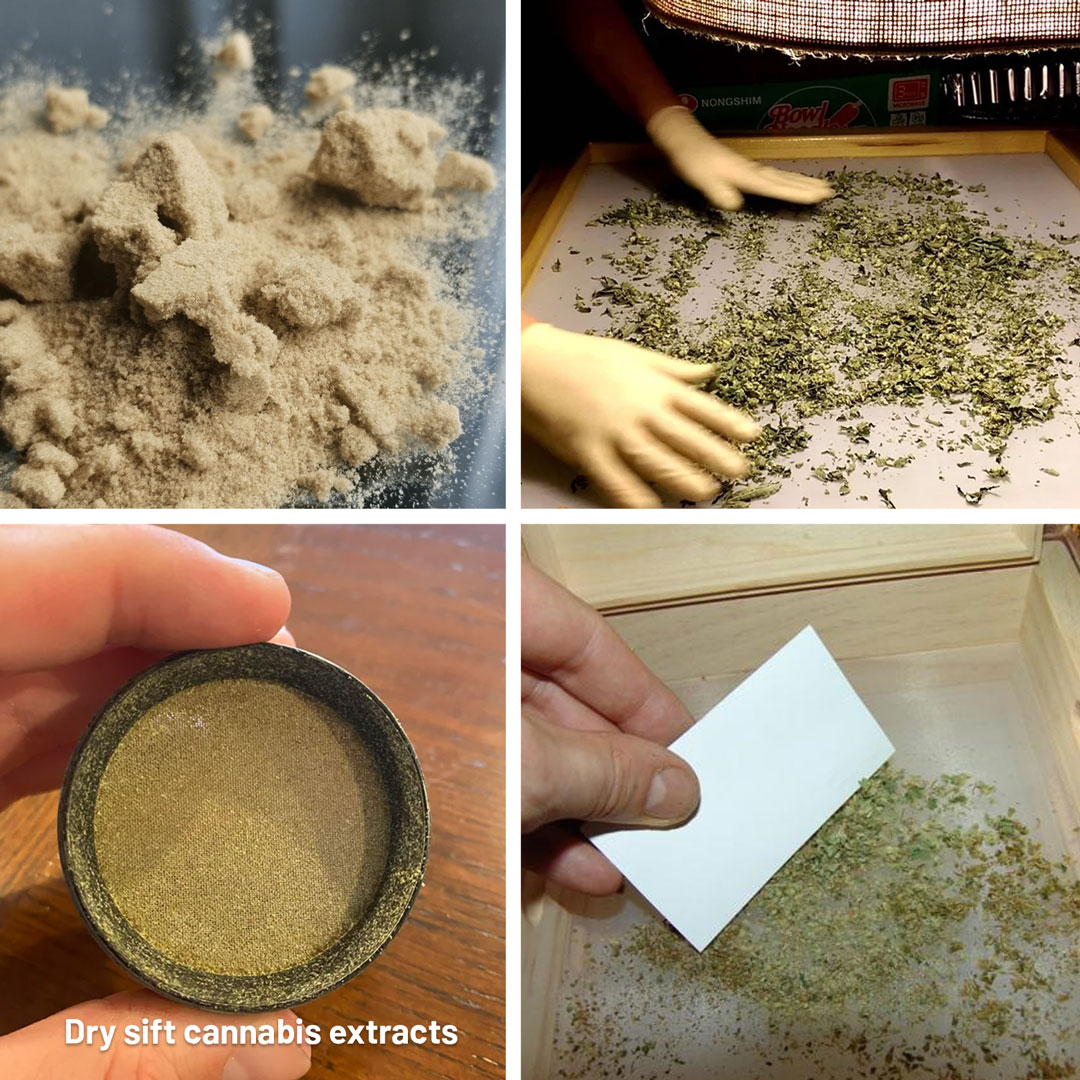
Dry sift cannabis is made using a similar principle to ice water hash, but without the water. Instead, the dry buds are shaken/rolled to remove the trichome resin glands. These pass through a wire-mesh type screen. As with ice water hash, the screen size restricts general plant material from passing through the screen.
Pros:
- Solvent-free, safe cannabis extracts can be made with a low up-front investment
- Expect great quality, high THC hash-style results
Cons:
- Whilst dry sift extracts are great quality and potent, the dry-sift method is not always the most efficient, meaning that your yields may be less than those from other methods, such as BHO, alcohol or Rosin extraction.
Best for:
Those that are less concerned by overall efficiency/yields, and who prefer a simple traditional solvent-free approach to producing their cannabis extracts.
Equipment needed:
Dry cannabis trimmings & a dry sift machine. Dry ice is an optional extra, the extra cooling it offers increases yields by freezing the trichomes and expediting their removal. Take into consideration that using dry ice decreases the quality a bit as more contaminants come through the screens.
Step-by-Step extraction process:
In order to mechanically separate the cannabis trichomes from the host plant material it needs to be dry. In its simplest form, all you need is a wooden/metal frame with a fine wire mesh screen. This is used as a sieve, allowing trichomes to pass through.
Dry-sift enthusiasts buy automated dry-sift machines. These can be cylindrical rotating tubes (or vibrating horizontal sieves) that mechanically agitate the plant material, separating the trichomes which fall through the sieve and are collected.
The use of dried cannabis flowers, leaves, popcorn buds or trimmings is all possible. The material should be kept as fresh as possible in a freezer preferably at around -20°C (-4F) until it is ready to be used in a dry sift tumbler or dry sift screen.
The dry sift is often a creamy coloured powder. Some press it into a hash ball, other leave it in a power form to add to a joint, vape etc. Some experienced dry-sift connoisseurs add dry-ice (cold, solid CO2 granules) to improve yields when they are sifting their plant material above the wire mesh screen. The dry ice helps freeze the trichomes, accelerating their mechanical removal from the host plant material. Dry ice use can also be beneficial when added to rotating cylinder-style dry-sift machines.
As with all cannabis extraction methods, higher quality starting material will yield the highest amounts of finished cannabis extract.
Many growers trim/manicure their buds over a sieve allowing them to collect the dry-sift produced as trichomes fall off the trimmed buds. Some less scrupulous weed growers put their cured buds briefly through a dry-sift tumbling machine to collect any dry sift before selling the buds. Another great reason to grow your own weed!
Note that many of the automated dry sift devices incorrectly imply that they are collecting pollen, when they actually collect trichomes (in theory, no pollen should be present when processing female cannabis flowers).
Dry frozen Whole Plant Fresh Frozen (‘WPFF’) sift:
A popular modern take on dry-sift is known as whole plant fresh frozen (WPFF). With this technique, the fresh buds and leaves are dry-frozen (CO2 dry ice granules are ideal for this).
Whole plant fresh frozen dry-sift is often regarded as the crème de la crème of sift extracts, with even seasoned cannabis concentrate fans claiming to be blown away with the exceptional terpy taste. However, whole plant fresh frozen dry sift is notoriously expensive (sometimes costing €/$/£60 per gram, comparable to the most expensive cannabis rosin extracts.
5. Ethanol or IPA cannabis extraction techniques
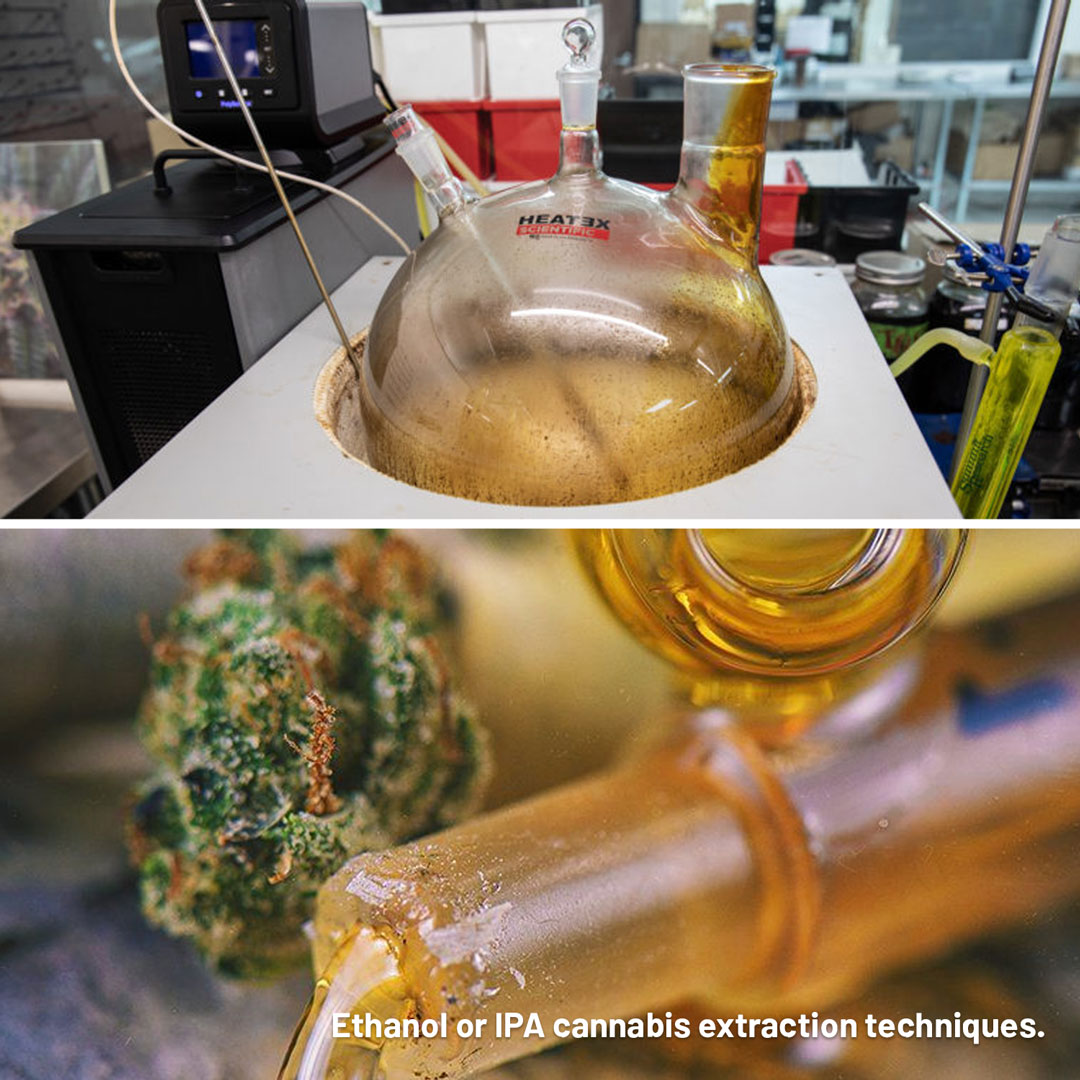
Dry cannabis foliage can be soaked in ethanol or IPA (Iso Propyl Alcohol). Fresh, undried plant material often produces slightly lower yields (compared to the mass of starting material) due to the residual water which restricts extraction efficiency.
Virtually all the cannabinoids, terpenes and plant oils are quickly dissolved in the solvent. Once the solvent is filtered & evaporated you are left with a pure, concentrated cannabis oil/shatter extract.
Pros:
- Very efficient, extracting most of the active ingredients
- Expect very strong, THC-rich cannabis extracts.
- A ‘short’ soak time in the alcohol will reduce yields somewhat but produce a more brittle ’shatter’ type product which may have a light colour. A longer soak time will produce slightly higher yields and a more liquid, oil-like, darker extract.
- Because the hash is made before any drying process, some terpenes that are usually lost during drying will still be in the end product, creating a unique product (assuming a freeze dryer is used to dry the hash).
Cons:
- Obvious risks of fire/explosion when using flammable organic solvents, especially indoors without the use of specialist air-extraction equipment (which prevents the build-up of explosive gasses)
- Careful and complete drying of your cannabis extracts is required to ensure they are free from residual solvents.
Best for:
Those that can safely manage the risks of organic solvents and are keen to get maximum extraction efficiencies from their plant material. Many medical cannabis users that produce their own cannabis oil using this technique.
Equipment needed:
- A safe working area with fume extraction.
- A container to soak your plant material in.
- Sufficient solvent (ethanol, IPA or perhaps acetone).
- A system to allow you to safely filter the solvent extract to ensure it is free from plant material.
- A way of safely evaporating the solvent away after your extraction is complete (various ‘essential oil’ distillation kits are available online for a few hundred €/$/£)
Step-by-Step extraction process:
For best results, the plant material should be dried first. The highest quality starting material will always produce the highest yields of cannabis extracts. As always, when using solvents or flammable gasses, professional fume extraction should be used and a safe working area created free from sources of ignition. This particularly suits the professional extractor rather than the home grower.
The dried plant material is soaked in the solvent, perhaps with stirring. This process normally takes a few minutes rather than a few hours. The solvent, containing the extracts, is drained off and filtered. Then the solvent is safely evaporated. Once this is complete you are left with the results of your solvent extraction.
A long soak in the solvent tends to produce a dark brown/black cannabis oil. A shorter soak often produces an amber/light-brown and brittle shatter-type product.
What yields of cannabis extract can I get from 100g of buds?
This scientific study suggests that an ethanol (aka alcohol) extraction can yield anything from 6%-29% of cannabis extract, depending on the quality of the starting material. So, a cannabis professional with a tried & tested ethanol extraction method might get up to 29g of cannabis extract from 100g of premium buds of their best strain.
The bulk of that (60-70%+) should be cannabinoids, the remainder will contain terpenes, plant oils and natural waxes. A first timer trying an alcohol extraction at home from 100g of medium quality buds might get nearer 15g of cannabis extract.
However, a first timer trying ice-water hash or dry-sifting at home might not get anything like that return. It’s good to remember that any cannabis extracts made from plant waste (popcorn buds, trim, leaves etc) is effectively cost-free, apart from a few hours of effort.
Those home growers that invest in specialist equipment to produce cannabis extracts tend to use that equipment for many years, producing premium concentrates that might be otherwise too expensive to buy.
Best cannabis strains to make extract
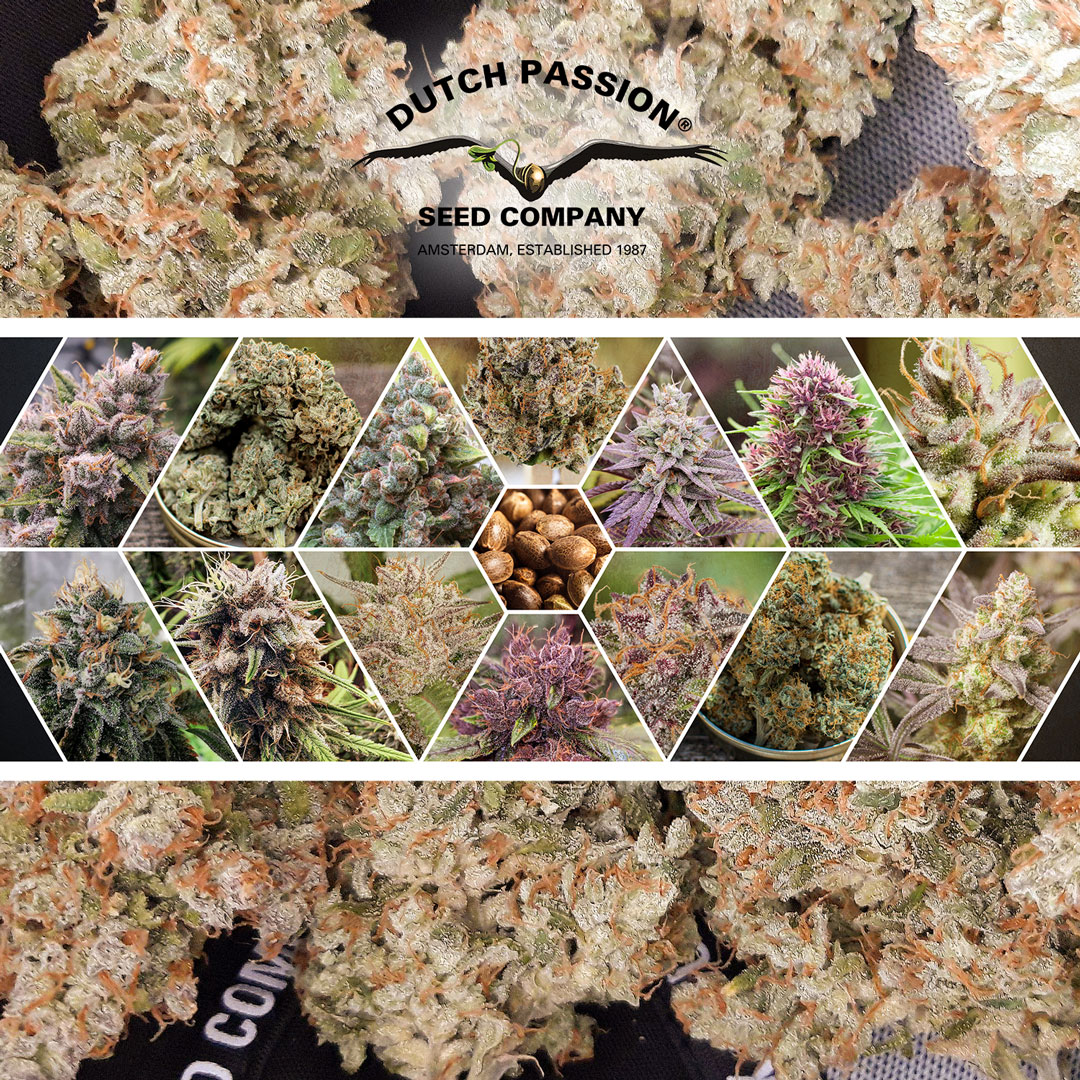
Cannabis extracts are a great treat for any cannabis lover. They are small & compact to pack away and store, or travel with. Best of all they offer delicious taste and a potent, supremely satisfying treat.
Some make their cannabis extracts with waste plant material/buds. But many actually save their best buds to make the finest quality cannabis concentrates possible. The more high-quality plant material that you start with, the better the quality/quantity of cannabis extracts you can make.
By definition, all cannabis concentrates are of superior quality than their starting material. You can make stunning quality extracts even from low quality plant trim. But the finest cannabis extracts come from the highest-THC cannabis seed varieties.
You can use material grown from autoflower seeds or feminised seeds. If you’re looking for the highest THC varieties that will really boost your cannabis extract production then Dutch Passion have assembled all their best strains into one convenient High THC cannabis seed collection. Any of these strains will provide 20%++ THC levels and in some cases 25%+ THC levels.
Enjoy your cannabis concentrates and be sure to make them safely!




























